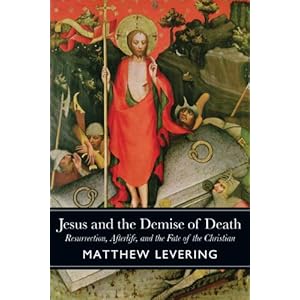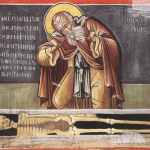
This post is part of the current Patheos blogger roundtable on Matthew Levering’s latest book from Baylor Press.
Anyone familiar with Matthew Levering must wonder to themselves, how does he write so much? Levering produces several thesis-type books per year, on top of teaching and editing a major journal (and other collected volumes). At least part of the answer, it seems to me, is that Levering has found a format that works for him. It started already in his doctoral thesis and has continued to form the basis of the majority of his books: Levering takes a contemporary problem in theology and puts today’s scholarship on the question into dialogue with Thomas Aquinas. In Levering’s latest work, Jesus and the Demise of Death: Resurrection, Afterlife, and the Fate of the Christian, Levering employs Thomas’s eschatology to clarify several contemporary questions about ‘end things.’ In Chapter 1, Levering addresses Aquinas’s view of Christ’s descent into hell on Holy Saturday. I found this intriguing because Thomas, at least in my experience, is rarely invoked in contemporary debates on this topic.
Scripture talks in many ways and many places about an intermediate state for those who die before Christ’s death and resurrection. On this Levering is agreed with contemporary scholars like the Anglican Bishop N. T. Wright and the Orthodox Metropolitan Hilarion Alfeyev. But Levering is not willing to affirm, with Wright, that such a state is uniform for all the saved – this is to abstract eschatology too much from history – nor is he willing to grant, with Alfeyev, that such a state offers a second chance at salvation – which would seem to imply a kind of second personal history. Levering desires that the intermediate state reflect the real choices made by human persons in their one and only personal history and so it will be experienced differently by different individuals without being a new history that offers “another life – with the same fundamental choice at stake” (p. 22) as the first.
It is important to note, then, that “hell” in this case does not mean exactly what it means for those of us living after Christ’s death and resurrection. (Hence the idea of the rough equivalence of “hell” or “the dead” in the creed pointed out by Ratzinger.) Heaven, hell, and purgatory cannot properly exist prior to Christ’s passion. In fact, and here Aquinas agrees with Balthasar and Ratzinger, though he never says so very explicitly, heaven, hell, and purgatory are constituted by Christ’s descent in to hell, that is, by his encounter with the dead in the intermediate state. Christ is the Omega, the end of all things. As such, perhaps the most useful way to think about eschatology is as encounter with Christ.
As Levering writes, pace Wright,
Aquinas does not think that all the inhabitants of the intermediate state are in the same condition. Due to the grace of the Holy Spirit, the “great cloud of witnesses” (Heb 12:1) is ready for Christ at his coming into the intermediate state. But others are not. (p. 24)
In other words, for those prepared to meet Christ, the encounter with him is itself the beginning of heaven. (I say “beginning” because they still await the resurrection of the body, something with which Levering deals in Chapter 2, Christ’s own resurrection, and Chapter 7, our resurrection.) Among those, however, who are not ready to meet Christ, there are two groups. Hell, as an intermediate state, can become hell as eternal and definitive separation from God for those whose rejection of Christ in their lives is made explicit by their encounter with Him. Those, on the other hand,
whose love is still divided . . . undergo in the intermediate state a further purification of their loves. Aquinas comments that “they who were such as those who are now in Purgatory, were not set free from Purgatory by Christ’s descent into hell.” [ST III, q. 52, a. 8] This does not mean that Christ’s presence had no impact on those who as yet could not fully welcome him. It simply means that they were unable to fully welcome him, and his love worked, as it always does, to heal them of this deficiency. (p. 25)
In other words, far from freeing them from purgatory, Christ’s descent inaugurates their purgatory. Purgatory is the encounter with Christ himself and his purifying love for us that exposes our divided hearts for what they are. And exposing evil is the first step in healing its effects. Is this not the dynamic highlighted in Scripture?
This is the judgment, that the light has come into the world, and men loved darkness rather than light, because their deeds were evil. For everyone who does evil hates the light, and does not come to the light, lest his deeds be exposed. (John 3: 19-20)
The real truth hidden in the language of a “second chance” after death, then, is not that we get a kind of mulligan on life but rather that that which was only implicit in this life becomes explicit in the presence of Christ. In him who is Truth, there will be no ambiguity. Christ’s descent to the lowest reaches of human existence is revelatory. It tells us who we really are. And for those willing to look honestly at such revelation – which for most will include a degree of personal purification – it is salvation.
________________________________________________________
Readers may also be interested in my Good Friday reflection from last year: Good Friday: Why Did Jesus Have to Die?
Brett Salkeld is a doctoral student in theology at Regis College in Toronto. He is a father of three (so far) and husband of one. He is the co-author of How Far Can We Go? A Catholic Guide to Sex and Dating and the author of Can Catholics Evangelicals Agree about Purgatory and the Last Judgment?












